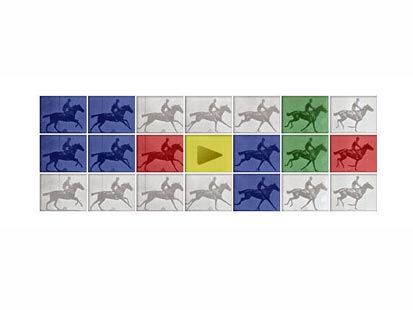Eadweard J. Muybridge: Why a Google Doodle?

Eadweard J. Muybridge Google Doodle
By Ronaldo Tumbokon
Today's stylized Google logo or "Google Doodle" consists of animated film strips of a galloping horse. These images were taken in 1877, long before the invention of the perforated film strip, to settle the question of whether a horse's four legs are airborne at the same time when trotting. The person who took the photos that settled the debate once and for all was Eadweard J. Muybridge - and he was born 182 years ago today.
Muybridge was an English photographer born on April 9, 1830. He spent much of his time in the United States where he took photos of Yosemite and San Francisco. He initially became famous for his landscape photographs that showed the awe-inspiring sprawls of the Western U.S.
In 1872, Leland Stanford, a former Governor of California, asked Muybridge to settle the much-debated of question whether a horse's hooves ever left the ground simultaneously when in full gallop. In 1877, he showed Stanford a single photographic negative displaying Stanford's horse airborne mid-trot.
In 1878, Stanford expanded the experiment by taking a series of photos using several large glass-plate cameras placed in a line. As horses passed the cameras, they triggered the shutters by tripping a thread. The images produced were viewed on a device that Muybridge invented called the zoopraxiscope, through the device the images appeared to be in motion. The slow-motion images showed exactly how, while running, a horses' four hooves leave the ground together. The series of images as seen in the zoopraxiscope is regarded as one of the earliest efforts in taking motion pictures and probably inspired Thomas Edison's invention of the kinetoscope.
Muybridge continued to study the movement of animals through the mid 1880's, using stop frame photography. He then published a collection of 20,000 pictures in a study called "Animal locomotion."
While still living in the San Francisco area, Muybridge shot the lover of his wife, igniting a scandal. He was acquitted for "justifiable homicide," left the US for Central America, and returned in 1877. He then returned to his native England for good in 1894 where he died in 1904.
Why does Google pay special tribute to people like Eadweard J. Muybridge? Perhaps Google wants to celebrate people who were ahead of their time, people who broke new ground and contributed to the advancement of human knowledge through futuristic visions - ideals that Google strives for as well.